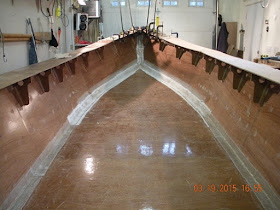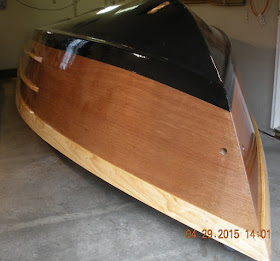Having built nine stitch-and-glue boats, I decided to build
a tenth and I
decided to design my own boat using a one-quarter scale model and computerized
drafting.
See Building BW Scale Model for more details
See Building BW Scale Model for more details
With the design complete, I compiled a list of materials. As
far as wood, there are only two types of wood in the BW – Hydrotek BS-1088
meranti plywood and clear pine.
 |
| Meranti sheets layed out for matching |
 |
| Hydrotek BS-1088 stamp |
The meranti plywood is not stocked locally but
the quantities are easily estimated so ordering and shipping went smoothly. The
clear pine is available at the local DIY store but finding pieces that are not
damaged, have minimal warp and are attractive, is difficult. Instead of buying
all of the pine at once, I bought a few sticks at a time so I could be picky
and get just the right pieces.
One of the challenges in building the BW was limited shop
space. Building an 8-foot x 23-foot boat in a 12-foot by 25-foot space was
interesting. I knew that once I stitched the hull together, it would occupy all
of the shop space leaving no room to fabricate the rest of the pieces.
I
fabricated the bottom panels, transom, side panels, knees, lifting strakes,
spray rails and rubrails in advance. After completing each piece, I hung it from
the ceiling to make room for more work. With all the pieces hanging from the ceiling,
the shop looked like a scene from a horror movie - a jungle of guillotines.
With fabrication of the individual pieces complete, it was
time to build a boat. The first step was to build the bottom. When I fabricated
the bottom panels, I stitched the keel line together. Now it was just a matter
of bringing the ½-inch panels down from the ceiling, spreading them open to the
desired deadrise along the length, and taping the keel line.
 |
| Taping of the keel |
At this point, the shape of the keel line is defined and I
can fabricate a keel. Sure, stitch-and-glue boats don’t have a “keel” so to
speak. Well, this one does. I built it with 2x6 and 2x10 hemfir lumber, joined
together with rabbet joints then cut to match the bottom panel keel profile and
deck profile. The final keel piece looks like an Nike swoosh stretched to 20 feet long with a
maximum depth of 14 inches.
 |
| Keel in place |
With the keel in place, I installed bulkheads and additional
structural members to create flotation chambers and additional connections
between the bottom and deck. The keel and five bulkheads on each side create twelve
flotation chambers.
 |
| Bulkheads in place |
After flipping,
the exterior of the keel is taped and the lifting strakes are installed.
 |
| Keel tape and lifting strakes |
Next step: install the deck. The deck spans from chine to
chine, extending past the bottom panels a few inches to create chine flats and
is made from a series of ½-inch meranti, with scarf joints. This boat requires
five deck panels, plus a few scraps, to complete the deck which provides the
lids for the twelve flotation chambers. I installed one deck panel each day,
using temporary clamping screws to hold the panels in place until the epoxy
cures. I removed all temporary clamping screws, during the entire build process
so that there are no metal fasteners in the boat.
 |
| Installing deck panels |
After all of the deck panels were
installed, the edges of the deck were trimmed to the final dimension, with a
20° angle to match the side flare.
 |
| Trimming deck panels |
Now this boat looks like a giant surf board.
See Another lovely bottom for more details
In order to provide support for the side panels, I installed the transom and some transom knees for extra support of the future outboard motors.
Here comes the fun part. I lowered the side panels down from
the ceiling, positioned them and stitched them to the transom and deck. The side
panels were pre-drilled for stitching and the stem was stitched before hanging
the side panels from the ceiling. Temporary spreaders were installed to get the
side panels to their final shape and the interior joints were epoxied and taped
with biaxial fiberglass. Typical of stitch-and-glue - after the epoxy cures, remove
the stitches.
Twenty-two knees, eleven per side, were epoxy-glued to the
inside of the side panels for connection to the future sheer deck. The sheer
deck is comprised of a layer of ½-inch ACX plywood covered by a layer of
3/8-inch meranti. The sheer deck was installed proud of the knees and side
panels then cut and sanded flush with the knees and side panels.
I installed the inwhale and rubrail with the top edges proud
of the deck. The top edges of the inwhale and rubrail were then cut and sanded
flush with the sheer deck. The cut edges of the inwhale and rubrail were rounded
and covered with fiberglass set in epoxy.
The spray rails were installed and the side panels and the boat was flipped.
 |
| Spray rails |
 |
| Flipping |
After flipping the boat, the exterior chine joints are epoxied
and taped with biaxial fiberglass and the bottom and side panels are completed
by painting the bottom and varnishing the side. The bottom cannot be finished
bright because the heavy biaxial fiberglass tape at the chines is opaque. The
paint extends up the side as needed to cover the biaxial tape and fairing. The
rest of the side panel is finished bright with varnish.
Time for another flip
 |
| Flipping her back upright |
Now the boat can be completed
For more details see The Last 10%
Build the pilothouse center console, put her on a trailer and install the motors and controls
See Pilothouse Console for details
Launch her and go for a ride!
 |
| Rear bench seat |
 |
| Forward locker |
 |
| Slop well |
Build the pilothouse center console, put her on a trailer and install the motors and controls
See Pilothouse Console for details
Launch her and go for a ride!
Same location...
...different build...
...25 years later
Other blogs by Mo 'Poxy


















No comments:
Post a Comment
Note: Only a member of this blog may post a comment.